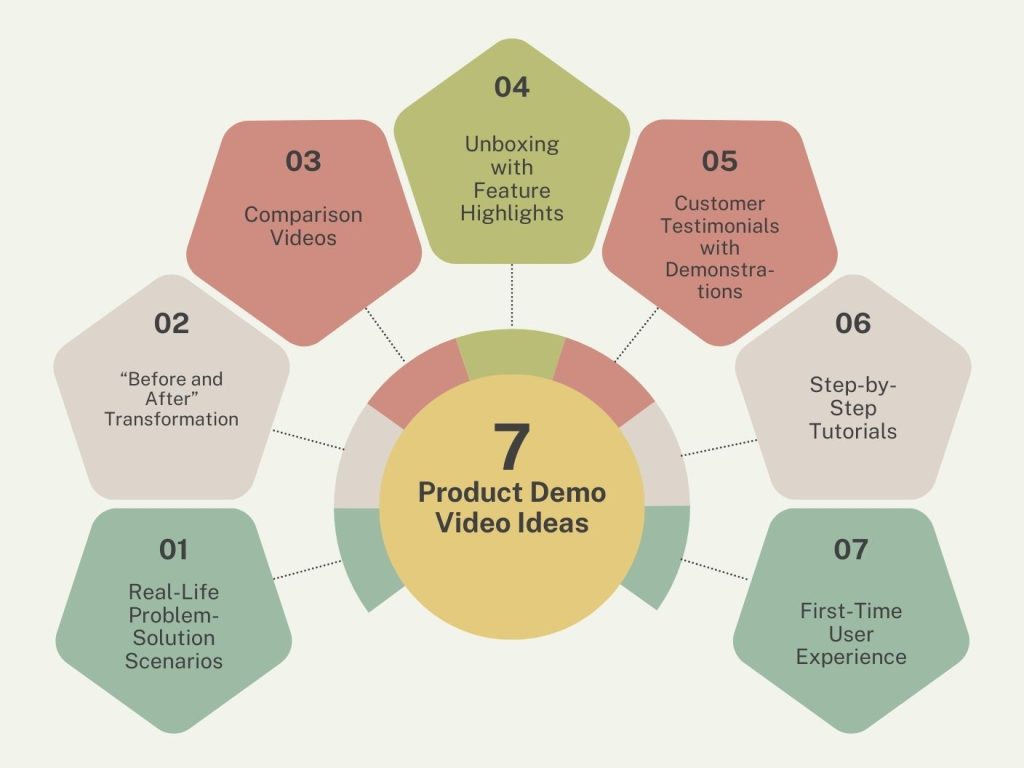Listen to this blog post:
Creating a product demo video is one of the most effective ways to showcase a product’s value, functionality, and unique features. A well-crafted demo video goes beyond simply explaining how a product works—it connects with the audience by solving their problems, answering their questions, and addressing their needs. For businesses, an impactful product demo video can drive engagement, build trust, and boost conversions by offering potential customers a clear and compelling view of what a product offers.
At Helio marketing company, we understand the importance of a demo video that truly converts. In this guide, we’ll cover best practices for creating a product demo video that stands out. From understanding your audience and planning a concise script to enhancing production quality and using a strong call-to-action, these strategies will help ensure your demo video motivates viewers to take the next step. Whether you’re creating product demos for your website, social media, or other platforms, following these guidelines will set you up for success in producing a video that informs, engages, and ultimately drives conversions.
What is a Demonstration Video?
A demo video is a short, targeted video designed to showcase a product’s features, functionality, and benefits clearly and engagingly. Its main objective is to educate potential customers about how the product works and to illustrate its practical applications. By walking viewers through key features, demo videos provide a comprehensive view of a product, helping them understand exactly what it does and how it can add value to their lives.
Unlike broader promotional videos, which focus on storytelling or brand identity, demo videos are more focused and detail-oriented. They prioritize functionality and clarity, often featuring step-by-step demonstrations or real-life scenarios to help viewers understand the product’s main attributes. This approach allows brands to communicate complex features effectively, breaking down information so that even new users can grasp the product’s potential.
The Role of Product Demo Videos
Product demo videos are crucial in building trust and confidence in a brand and its offerings. They provide an authentic look at the product, addressing common questions or concerns of potential customers. By showing the product in action, demo videos create transparency, allowing viewers to see firsthand how the product performs, which can reduce hesitations or doubts.If you need more related subject; You can also study creative concept development in video production.
Additionally, demo videos simplify complex features using clear visuals and practical examples. This is particularly valuable for products with unique technology, intricate designs, or specialized functions. Rather than leaving customers to decipher complex descriptions or instructions, a demo video can guide them through key features in a digestible, visual format. This makes it easier for customers to understand the product and helps them make informed purchasing decisions based on an accurate view of its capabilities.
In essence, a well-crafted demo video is a bridge between customer interest and decision-making. It allows brands to highlight what makes their product unique and essential, encouraging viewers to take the next step confidently. For many businesses, a high-quality demo video is the most compelling way to turn curious viewers into satisfied customers.

Best Product Demo Video Examples
Product demo videos can be a powerful way to convey a product’s value, especially when they effectively highlight benefits, show the product in action, and address customer needs. Here, we explore some examples of product demo videos across various industries and identify the qualities that make them effective.
Product Demo Videos
- Apple – iPhone Feature Demonstration
Apple’s iPhone demo videos are renowned for their simplicity and clarity. By focusing on specific features like camera quality, Face ID, and unique apps, Apple showcases the product’s benefits in a way that is visually engaging and easy to understand. Apple’s minimalist style and focus on real-life applications make these videos highly effective in communicating what sets the iPhone apart. - Slack – Team Communication Simplified
Slack’s demo videos use a mix of animation and live-action to show how the platform improves team collaboration. By highlighting features like channel organization, file sharing, and integration with other tools, Slack’s demos make complex software accessible to new users. This clear, structured approach helps viewers quickly grasp how Slack can simplify their workflows. - Dyson – Vacuum Cleaner Performance
Dyson’s product demos emphasize the engineering and power behind its vacuum cleaners. Dyson showcases its quality and durability by showing the product’s suction capability on different surfaces. The videos are highly visual, focusing on practical demonstrations that give viewers a clear understanding of the product’s performance.
Demo Video Examples Across Industries
- Tech – GoPro Action Cameras
GoPro uses action-packed footage shot by real users to highlight the durability and versatility of its cameras. By featuring extreme sports and outdoor adventures, GoPro’s demo videos allow viewers to see the product’s capabilities firsthand, making them ideal for adrenaline seekers and travel enthusiasts. - Fitness – Peloton Bikes
Peloton’s demo videos focus on the interactivity of its exercise bikes, showcasing live classes and user engagement features. By presenting the product within a fitness context, Peloton effectively connects with an audience looking for convenient ways to stay active at home. - Kitchen Appliances – Vitamix Blenders
Vitamix creates demo videos that showcase its blender’s power and versatility. Through demonstrations of various recipes, Vitamix positions itself as an essential tool for home cooks and health enthusiasts. The videos emphasize ease of use and high performance, which appeal directly to a food-focused audience. - Beauty – Glossier Skincare
Glossier’s demo videos highlight its skincare products by showing real people using them. The brand’s demos focus on transparency and authenticity, using a clean aesthetic and relatable models to create a personal, approachable feel. This resonates well with beauty consumers seeking effective, simple skincare. - Home Improvement – Nest Thermostats
Nest’s demo videos show how its smart thermostats integrate with other home devices. The videos explain product features like remote control, energy savings, and easy installation, making the complex world of smart home technology accessible and appealing to everyday users.
How to Make a Demo for a Product: Step-by-Step Guide
- Set Your Goal and Identify Key Features
Start by clarifying what you want to achieve with the video. Are you focusing on awareness, engagement, or sales? Based on this goal, identify the most important features to showcase. For example, choose features that solve common customer pain points if the goal is to explain functionality. - Write a Script
A well-structured script is essential for keeping the video focused and engaging. Begin with a brief introduction to the product, followed by a demonstration of key features. Use simple and relatable language, and avoid technical jargon unless it’s essential for your audience. Aim to keep the script concise, sticking to one main idea per feature. - Plan Visuals and Shots
Plan each scene and visual, ensuring every shot aligns with your message. For physical products, show the item from various angles and demonstrate it in real-life situations. For digital products, use screen recordings or animations to illustrate key functions. Close-up shots are particularly effective in showcasing details, while wider shots can show the product in use. - Record High-Quality Footage
Use a high-resolution camera and ensure proper lighting to make your product stand out. Natural lighting can work well if filming on a budget. Use a tripod to avoid shaky footage, and invest in a good microphone for clear audio. High production quality helps create a polished look that resonates with viewers. - Edit and Add Branding Elements
Edit the video to ensure smooth transitions and remove any unnecessary content. Add branding elements like logos, colors, and fonts consistent with your brand identity. Use text overlays to highlight essential points or call attention to specific features. Effective editing makes the video visually engaging and keeps the focus on key information. - Add a Call-to-Action (CTA)
Conclude the video with a CTA that aligns with your objective. For instance, if the goal is to drive sales, use phrases like “Shop Now” or “Try it Today.” Ensure the CTA is visually prominent through on-screen text or a verbal prompt.
Tips for Success
- Keep It Short and Impactful: Aim for brevity to maintain viewer attention. A product demo video generally works best between one to two minutes, focusing on the most impactful points.
- Use Relatable Scenarios: Show the product in real-world use cases that resonate with your target audience. This helps viewers see the product’s value in their own lives.
- Incorporate Customer Testimonials: Including customer feedback or brief testimonials can enhance trust, adding a layer of social proof to the product demo.
- Test and Refine: After creating the video, test it with a sample audience and gather feedback on elements like clarity, engagement, and message. Use viewer metrics to determine if any adjustments are needed to improve effectiveness.
Finding out How to select a video production company in Dubai can make a big diffrence in the quality of your final project.

| Step | What to Do | Why It Matters |
|---|---|---|
| Set Your Goal | Define the purpose: awareness, engagement, or sales. Identify key features to highlight. | Ensures the video aligns with your objectives and showcases the most relevant product benefits. |
| Write a Script | Create a clear, concise script. Introduce the product, demonstrate key features, and add a CTA. | Keeps the video focused, engaging, and easy to follow for the audience. |
| Plan Visuals and Shots | Outline each scene. Use close-ups for details, wide shots for context, and real-life scenarios. | Ensures the visuals effectively communicate the product’s functionality and appeal. |
| Record High-Quality Footage | Use good lighting, a stable camera, and clear audio. Highlight product use in real-world settings. | Professional footage builds credibility and keeps viewers engaged. |
| Edit and Brand the Video | Add smooth transitions, text overlays, and branding elements (logos, colors, fonts). | Creates a polished, cohesive look that reinforces brand identity. |
| Add a Call-to-Action (CTA) | End with a clear prompt, like “Buy Now,” “Learn More,” or “Sign Up Today.” | Guides viewers to take the next step, increasing conversions. |
| Test and Refine | Share the video with a sample audience for feedback. Optimize based on clarity, engagement, and impact. | Ensures the video resonates with viewers and meets its intended goals. |
How to Create Product Demo Videos for Social Media
Creating demo videos for social media requires unique considerations to maximize engagement and reach.
Optimize for Social Media Platforms
Social media platforms like Instagram, Facebook, and TikTok have content styles, audience expectations, and technical requirements. Tailoring your demo video to suit each platform can improve visibility and engagement.
- Focus on Short, Engaging Content
Social media audiences respond best to shorter videos, so aim for 15-60 seconds to capture attention quickly. Emphasize the most compelling feature first to grab viewers’ interest and consider breaking down longer demos into bite-sized pieces for social media sharing. - Use Vertical or Square Format
For Instagram Stories, Reels, and TikTok, use a vertical (9:16) format to take advantage of the entire screen. For Facebook or Instagram feeds, square (1:1) videos are effective. These formats maximize screen real estate and are more user-friendly on mobile devices. - Add Captions
Many social media users watch videos without sound, so adding captions ensures that viewers understand your message even if the video is muted. Captions make the content accessible and help maintain engagement for viewers in sound-off environments.

Best Practices for Optimizing Social Media Demos
- Catch Attention Quickly
The first few seconds are critical. Use eye-catching visuals, movement, or a strong opening message to capture attention immediately. Avoid long intros; dive straight into the most important content to keep viewers hooked. - Encourage Sharing and Interaction
Include prompts encouraging viewers to like, comment on, or share the video. Social engagement can increase your reach on social media platforms, helping your content reach a wider audience. - Use Hashtags and Optimize Descriptions
Hashtags make your content more discoverable on social platforms. Use a mix of popular and niche hashtags related to your product and industry. Optimize the video description with relevant keywords to improve visibility and reach. - Leverage Platform-Specific Features
Each platform offers unique features that can enhance your demo video’s appeal. For instance, TikTok offers music overlays and effects, while Instagram Stories includes interactive stickers and polls. Tailoring your video to include these features can make it more engaging and align it with the platform’s style.
By following these strategies, you can create effective product demo videos for social media that attract attention, drive engagement, and build brand awareness. Social media is an ideal platform for demo videos because it allows instant feedback and the chance to reach new audiences with visually compelling content.
Read More: Everything you should know Video Marketing
Product Demo Video Ideas
An engaging product demo video can capture attention, educate viewers, and drive conversions. Whether introducing a new product or showcasing features of an existing one, here are creative ideas, key components, and best practices for creating a demo video that resonates with your audience.
- Real-Life Problem-Solution Scenarios
Start by identifying a common problem your target audience faces and demonstrate how your product solves it. For example, a skincare brand might show someone struggling with dry skin, followed by a demonstration of how their moisturizer hydrates and rejuvenates. This approach helps viewers immediately relate to the product. - “Before and After” Transformations
For products with visible results (e.g., cleaning products, fitness equipment), a “before and after” format can be highly effective. Show the initial state, apply the product, and then reveal the result. This type of demo highlights the product’s effectiveness and can leave a strong impression on viewers. - Comparison Videos
If your product stands out against competitors, create a comparison demo to emphasize its unique benefits. For example, demonstrate your product’s features side-by-side with a leading competitor’s, highlighting aspects like durability, performance, or ease of use. Comparison videos are particularly compelling for customers in the decision-making phase. - Unboxing with Feature Highlights
An unboxing demo can capture viewer interest in products with unique packaging or multiple components. Unbox the product and briefly explain each item’s purpose. This works especially well for tech gadgets, beauty boxes, or premium products where packaging is part of the experience. - Customer Testimonials with Demonstrations
Incorporate testimonials from real customers who can vouch for the product’s benefits. Let them demonstrate how they use it in their own lives, blending personal storytelling with a live product demo. This approach builds trust and resonates strongly with potential buyers. - Step-by-Step Tutorials
If your product has multiple features or requires assembly, a step-by-step tutorial can simplify the process for viewers. Highlight each step in an easy-to-follow manner, showing how intuitive and user-friendly the product is. Tutorials are effective for software, fitness equipment, or anything with a learning curve. - First-Time User Experience
Show a first-time user trying the product to capture an authentic, real-world experience. This approach appeals to viewers who might be new to the product, as it often addresses common questions or initial challenges. Seeing an unpolished, first-time-use scenario can make the demo more relatable and transparent.

What Makes a Product Demo Video Great
A great product demo video doesn’t just list features—it connects with viewers, addresses their needs, and builds a memorable experience. Here are key elements that elevate a demo video:
- Storytelling
Storytelling brings the product to life, transforming a straightforward demonstration into an emotionally engaging narrative. By showing how the product integrates into daily life or solves specific challenges, storytelling creates a personal connection with viewers. It can be as simple as narrating a “day in the life” scenario with the product or showing the journey from problem to solution. - Clear and Engaging Visuals
Visual quality is essential to keeping viewers engaged. Use clear, high-resolution shots that show every detail, ensuring that key features are easy to see. Zoom in on intricate components, use wide shots for context and add smooth transitions to guide the viewer’s eye. Graphics or animations can also enhance the visual appeal, especially for software demos where screen recordings may need additional emphasis. - Customer-Centric Focus
Addressing customer pain points and needs makes the video more relevant. Instead of describing the product, highlight how it meets specific challenges or makes the customer’s life easier. For instance, a food processor demo might highlight how it simplifies meal prep for busy parents. - Concise and Focused Messaging
Effective demo videos avoid lengthy explanations and use one or two main features. Each second counts, so keep the messaging direct and concise. Avoid overloading the viewer with technical details; focus instead on high-impact information that viewers can quickly grasp. - Strong Call-to-Action (CTA)
Conclude the video with a clear, actionable CTA that encourages viewers to take the next step, whether visiting the website, signing up for a free trial, or purchasing. A good CTA provides direction and turns viewer interest into engagement or sales.

How Long Should a Product Demo Video Be?
The ideal length for a product demo video depends on the platform, audience, and product complexity. Here are the general guidelines:
- Social Media Platforms (Instagram, Facebook, TikTok)
For social media, brevity is essential. Aim for 15-60 seconds, focusing on one or two main features. Social media viewers often have limited attention spans, so grab their interest quickly and make your message clear. For Instagram Stories or TikTok, 15-30 seconds is ideal to capture attention within a short viewing window. - Website or Product Page
Viewers expect more in-depth information on a product page so that a demo video can run a bit longer. Aim for 1-2 minutes, allowing enough time to cover essential features and benefits while maintaining viewer engagement. Videos on product pages are often closer to the decision-making stage, so slightly more detail can be helpful. - Email Marketing
For demo videos embedded in emails, keep the length under 1 minute to ensure viewers stay engaged and don’t lose interest. The purpose here is usually to spark interest, so shorter videos work best in this context. - In-Depth Tutorials or Explainers (YouTube)
Platforms like YouTube are suitable for longer, detailed demos or tutorials. For more complex products that require thorough explanation, aim for 2-5 minutes. This gives you room to cover all important aspects without rushing, but only exceeds 5 minutes unless the product demands a detailed overview. - Live Demonstrations (Webinars, Live Streams)
Live demos or webinars allow for real-time engagement and can be longer—usually 10-30 minutes. This format works well for products that benefit from Q&A sessions or interactive demonstrations. Live demos allow one to answer specific viewer questions, making them ideal for building trust and fostering direct engagement.
By selecting the right format and duration based on your platform and audience needs, you can optimize your product demo video’s effectiveness, ensuring that it captures attention and keeps viewers engaged.

Product Promo Video or Live Demo: Which is Most Effective?
Both recorded and live demos offer unique benefits when it comes to showcasing a product. Each format has distinct strengths, and choosing the right one depends on your product, audience, and marketing objectives. Below, we explore the advantages of each type, when to use them, and insights on which format may be most effective for different situations.
Recorded vs. Live Product Demos
Recorded and live product demos each have unique advantages. Here’s a comparison to help determine which is best based on goals, audience, and content type.
Recorded Product Demos
Recorded demos are pre-produced, polished videos that highlight a product’s key features, benefits, and uses. They are typically edited for clarity, pacing, and production quality, allowing brands to present a highly controlled and visually appealing narrative. Recorded demos can be used repeatedly, easily shared on various platforms, and provide an evergreen resource for potential customers.
Advantages:
- Polished and High-Quality: Recorded demos are edited for smooth transitions, sound quality, and visual appeal, making them appear professional and engaging.
- Evergreen Content: Once produced, recorded demos can be shared across multiple platforms, including websites, social media, and emails, providing a long-lasting asset.
- Consistency: Since the video is pre-recorded, every viewer sees the same content, ensuring consistent messaging and presentation.
Disadvantages:
- Limited Interaction: Unlike live demos, recorded videos don’t offer real-time interaction, making it harder to address viewer questions on the spot.
- Static Format: Recorded demos are less adaptable and don’t allow for spontaneous adjustments based on audience reactions or feedback.
Live Product Demos
Live demos are conducted in real-time, often via platforms like Instagram Live, Facebook Live, or Zoom. They allow for immediate audience interaction, creating a dynamic experience where viewers can ask questions, request clarifications, or see the product in various scenarios. Live demos are particularly effective for building authenticity and engaging audiences directly.
Advantages:
- Real-Time Engagement: Live demos let viewers interact with presenters, ask questions, and receive instant answers, creating a more personalized experience.
- Authenticity and Trust: Live streaming shows the product in real-time, fostering transparency and trust as viewers see the product’s unedited performance.
- Adaptability: Presenters can adjust the demo based on audience feedback, demonstrating specific features or addressing concerns as they arise.
Disadvantages:
- Unpredictability: Live demos may experience technical issues, unexpected interruptions, or on-the-spot challenges that can impact the flow.
- Limited Shelf Life: Although live demos can be recorded and reused, their primary value is in the real-time experience, and they may lose impact when re-watched later.

Benefits of Each Type
Both types are valuable, with recorded demos ideal for consistent, on-demand content and live demos excelling in interaction and real-time engagement.
When to Use Recorded Product Demos
Recorded product demos work well for businesses looking to create high-quality, shareable content that can be used over time. Use recorded demos when:
- Launching a New Product: A polished video can introduce the product professionally, providing an ideal first impression.
- Focusing on Consistent Messaging: If your goal is to communicate specific features consistently, a recorded demo allows you to control every detail.
- Creating Evergreen Content: For products that won’t change significantly, a recorded demo offers lasting value. You can embed it on your website or share it on social channels for months or years.
When to Use Live Product Demos
Live product demos are best for engaging audiences in real-time and building trust through transparency. Use live demos when:
- Conducting Q&A Sessions: Live demos are ideal for products that need further explanation or have detailed features. They allow viewers to ask questions and get instant answers.
- Building Community and Engagement: Hosting a live demo can foster community, especially on social platforms where viewers can interact with the brand and other customers.
- Demonstrating Complex Products: A live demo can adapt to audience needs for products with multiple uses or technical components, showing specific features on request.

Live vs. Recorded Demos: Which Format Works Better?
For Simple, Visual Products
For straightforward products that primarily rely on visual appeal (e.g., beauty products, fitness equipment), recorded demos are often more effective. A recorded video can be polished to perfection, showcasing the product’s appearance, features, and benefits visually compellingly.
For Technical or Complex Products
Live demos are generally more suitable for more technical products that may require user guidance or in-depth explanation (e.g., software, tech gadgets). The real-time interaction allows the presenter to address specific audience questions, adapt the demonstration to different use cases, and provide more personalized insights.
For High-Trust Products
For products that benefit from building trust through authenticity (e.g., food, wellness, or skincare items), live demos offer a more transparent look. When viewers can see a product’s performance in real-time, it reinforces confidence in the brand and product, as there is no editing or scripting to alter the experience.
For Wider Reach and Multi-Platform Use
Recorded demos are ideal for sharing across multiple platforms, including websites, emails, and social media channels. They provide a consistent message that can be tailored to fit different formats and are often more efficient for reaching a broad audience with a single video.
For Community Engagement and Building Relationships
Live demos are more effective if the goal is to foster community interaction and create a closer bond with your audience. Real-time interaction invites viewers to participate, share feedback, and feel personally connected to the brand, which can be highly valuable for long-term loyalty.
Both live and recorded demos have unique strengths, and often, combining both formats can deliver the most effective results. Brands can start with a recorded demo for consistency and shareability, then host periodic live sessions to answer questions, provide updates, and build community. By leveraging the right format for the right audience and product type, brands can create powerful demo experiences that engage, inform, and convert.
Conclusion
Product demo videos are invaluable tools for showcasing a product’s functionality, benefits, and unique features. Whether recorded or live, a well-crafted demo video captures attention, builds trust, and effectively guides potential customers toward making informed purchasing decisions. This article explored the key elements of impactful demo videos, including clear messaging, high production quality, and a compelling call to action. By understanding when to use recorded versus live demos and applying best practices like concise scripting, storytelling, and visual clarity, brands can maximize the impact of their product demos.
At Helio Video Production Firm, we encourage you to incorporate these strategies in your product demos to enhance viewer engagement and drive conversions. A great demo video communicates the value of a product and connects with audiences on a personal level, leaving a lasting impression.
If you’re ready to take your product demo video to the next level, Helio Video Production firm is here to help. We’d love to hear about your experiences or assist you in creating professional, high-converting demo videos. Reach out to our team to bring your brand’s story to life with engaging, effective video content.





